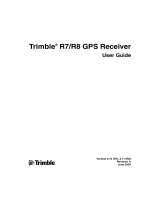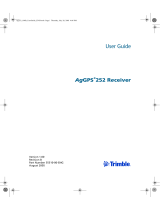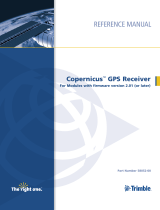
Appendix A – Specifications
ENVIRONMENTAL SPECIFICATIONS
Operating temperature
-40
o
C to +85
o
C
Storage temperature -55
o
C to +100
o
C
Vibration 0.008 g
2
/Hz 5Hz to 20Hz
0.05 g
2
/Hz 20Hz to 100Hz
3bD/octave 100Hz to 900Hz
Operating humidity 5% to 95% R.H., non-condensing, @ +60
o
C
Altitude -400m to +18,000m
PERFORMANCE SPECIFICATIONS
General L1 frequency, C/A code (SPS), 12-
channel continuous tracking receiver
Update rate 1 Hz (TSIP,NMEA, or TAIP)
Accuracy Position - Horizontal: <5m (50%), <8m (90%)
Position - Altitude: <10m (50%), <16m (90%)
Velocity: 0.06 m/sec
1 PPS (static) ±50 nanoseconds
DGPD accuracy Positoon: 2m CEP (50%)
Velocity: 0.05 m/sec (1 sigma)
Time: ±500 nanoseconds (nominal)
Acquistion Cold start: <50 sec (50%) <84 sec 90%
Warm start: <38 sec (50%) <42 sec 90%
Hot start: <10 sec (50%) <13 sec 90%
Cold start requires no initialzation. Warm start implies last position, time
and almanac are saved by back-up power. Hot start implies ephemeris also
saved.
Racquistion after signal loss
<2 seconds (90%)
Dynamics
Accerlation 4g (39.2 m/sec
2
)
Motional Jerk 20 m/sec
2
Operational Limits Altitude <18,000m or velocity <515 m/sec
Either limit may be executed but not both
TECHNICAL SPECIFICATIONS
Prime Power +9 to +32 VDC input
Power consumption (nominal)
25 mA, 30 mW, at 12V, +25
o
C, with antenna
Back-up power +3.0 to +12 VDC (20 µa @ +3.3V, +25
o
C)
Serial ports (2) RS-232
I/O Protocol options TSIP (Trimble Standard Interface Protocol)
@ 9600 baud, 8-Odd-1
TAIP (Trimble ASCII Interface Protocol)
@ 4800 baud, 8-None-1
NMEA 0183 v3.0 @ @4800 baud, 8-None-1
RTCM SC-104 @ 4800 baud, 8-None-1
NMEA messages Standard: GGA and VTG
Optional: User-selectable combination of;
GGA, GLL, VTG, ZDA, GSV, GSA and
RMC; user can store configuration in non-
volatile memory
PHYSICAL CHARACTERISTICS
Dimensions
Metal Enclosure 4.03” D x 4.97” W x 1.1” H
(102mm x 127mm x 28mm)
Mounting flange 4.03” D x 6.81” W x 1.1” H
(102mm x 173mm x 2mm)
Weight 0.57 lb. (0.26kg) (board + enclosure + flange)
Connectors
Antenna MCX
Serial data (2) DB9
Power 3-pin Conxall
A-1




















